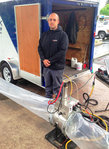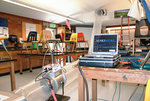


Ask most homeowners how they might save big money on heating and cooling their house, and you’ll probably hear things like “replace my furnace” or “insulate the attic.” One thing you’re not likely to hear? “Seal the ducts.”
But fixing leaky ducts is, according to the U.S. Environmental Protection Agency (EPA), one of the very best ways to make a home more efficient and save homeowners money on their heating and cooling bills.
“Leaky ducts can reduce heating and cooling system efficiency by as much as 20 percent,” states a 2009 EPA report. “Sealing and insulating ducts increases efficiency, lowers your energy bills, and can often pay for itself in energy savings.”
In fact, many energy efficiency experts say duct sealing has more bang for its buck than insulating your basement or attic, replacing your furnace or upgrading your windows.
In 2009, the U.S. government commissioned a study on energy efficiency and its impact on our nation’s economy. That report found that: “Duct sealing can be far and away the most effective strategy for reducing energy costs for homes, small offices and commercial buildings.” According to the research, sealing ducts “has twice the impact of upgrading the heating equipment and 500 percent more impact than upgrading the windows.”
Chris McKinney, a building science specialist with the Entek Corporation in Vancouver, has long known the importance of fixing leaky ducts to improve a home’s energy efficiency.
“Washington is on the cutting edge when it comes to duct sealing,” McKinney says. “If you replace your heating system, you have to do a duct test in this state.”
That doesn’t mean that homeowners must seal the ducts, but it does mean that they’ll have the information they need to make an informed decision. Entek, the company where McKinney works, services residences, businesses and nonprofits throughout Clark County and the greater Portland-Vancouver metropolitan region. They are one of the only companies to offer a product known as Aeroseal, an extremely effective duct sealant.
“We always do the duct test before replacing the heating system,” McKinney says. “You can do it after, but we think customers prefer to know … I mean, if you had eight holes in the bottom of your boat, wouldn’t you want to know before you had work done on it?”
Many times, homeowners come to Entek thinking that they need a bigger air conditioning unit or an expensive overhaul to their heating system. But, says McKinney, some of these customers simply need to seal their ducts to experience a warmer/cooler home and less expensive heating/cooling bills.
“People come to us and say, ‘There’s dust in the house,’ or ‘There are mice in the house,’” McKinney says. “But these are common with duct problems.”
Your house wants to regulate itself, McKinney explains. If it’s cold outside and the heater is on, but your ducts aren’t properly sealed, warm air will get out and cold air will be sucked in. The opposite is true in the summertime – cooler air goes outside and warm air, usually from the attic, which can get up to 140 degrees on a hot, summer day, is pulled down into your living areas.
In the not-so-distant past, duct installers used duct tape to seal the gaps. But duct tape becomes brittle over time and, eventually, those gaps open and allow air to flow in and out of your house.
With a product like Aeroseal, which is pumped into the duct system as a clear, aerosolized vinyl polymer, plugs any openings with a glue-like liquid and hardens after about 30 minutes, your ducts can stay sealed for about 40 years, saving the average homeowner on their monthly heating/cooling bills. The cost of Aeroseal? About $1,500 to $2,400 for the typical home, McKinney says. With rebates, tax incentives and actual energy cost savings, the average residential Aeroseal customer will save between $600 and $850 in the first year alone.
Used in conjunction with other efficiency methods – hand-sealing exposed ducts, replacing an old furnace and insulating your attic, for instance – the Aeroseal can bring a home into the upper echelons of energy efficiency.
“We’ve been using it for about four years,” McKinney says of the Aeroseal product. “Hand sealing is great, but you can only do the ducts that you can reach. Aeroseal seals the ducts that we can’t access by hand.”
Entek, which has offices in Vancouver and Longview, has installed Aeroseal in residential homes, corporations and nonprofits – including schools and hospitals – throughout Washington and northwestern Oregon. The Entek technicians have learned the best practices for applying the Aeroseal, McKinney says, and understand the importance of thoroughly preparing the site before pumping the Aeroseal into the home’s duct system.
For more information about Aeroseal, visit www.aeroseal.com, or watch the video that McKinney put together for Entek customers, showing how Aeroseal works, at https://www.youtube.com/watch?v=xmxbt6ZYymU.
For more information about Entek’s heating and cooling services, visit www.entekhvac.com, or call (800) 633-1354.